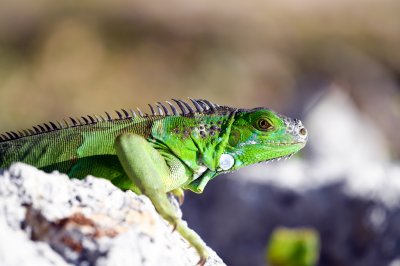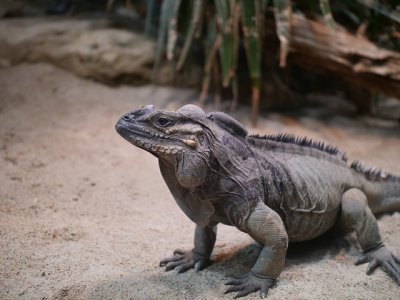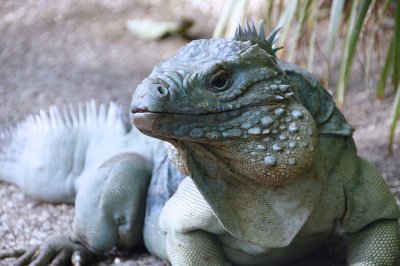So you want a pet Iguana? That's wonderful, but are you up for the task? Keeping a pet Iguana - or any reptile, for that matter - isn't as simple as having a cat or dog. These creatures do require quite a bit of set up and some specific care. Before you embark on pet parenting one of these scaly critters, we have compiled a list of things to consider. Plus, we have tracked down the top five Iguana types for pets.
Let's get started!

Am I Ready for an Iguana?
Here are some things to keep in mind before you adopt an Iguana as a pet.
Size
Depending on the breed of the Iguana, these reptiles can reach weights of 20 plus pounds and reach lengths of over six feet. A creature of that magnitude is going to require a very sturdy, very large enclosure.
Habitat
In their natural habitat, Iguanas spend most of their time either in the trees or on the desert floor. Can you provide this pet with an enclosure that is proximity to nature? Do you have the space it will need to roam free or climb to its heart's content?
Heat/Humidity
Iguanas live in tropical or desert regions, which means their daytime temperature and humidity levels are most likely going to be vastly different than how we keep our own living spaces. These conditions must be met according to each species of iguana for it to remain healthy and happy.
Safety
Did you know a full grown Green Iguana has the potential to break a human arm with a strike of its tail? Unlike a dog or cat that has been domesticated over the years, Iguanas have not. For this reason, they will retain their "wildness" and natural defenses (using their tail like a whip). Of course, you would have to really tick off your pet for it to feel threatened enough to strike, but it still has to be kept in mind, especially if you have small children or other pets.
Not so Cuddly or Interactive
Reptiles are not known for their cuddly or interactive behaviors, so if you're looking for either one of these qualities in a pet, you may want to reconsider the Iguana.
If you still think a pet iguana is the best choice for you, then here are the top five species that can be kept as a pet.
Iguana Types for Pets
1. The Green Iguana

The cute "little" iguana you see at most pet stores is probably the Green Iguana variety. According to Reptile Magazine, around one million of this species are imported into the U.S. each year.
The Green Iguana's appearance is mostly affected by its origins and how it is being kept. Generally, this species has a very long tail (up to three times its body length), a promient dewlap under its chin and one (or more) enlarged scales below the eardrums. The males will have longer spikes running down their backs.
Personality-wise, the Green Iguana is intelligent and can even come to recognize their handler. Some pet parents of this species have said their Green Iguana is "affectionate."
- Size: Up to 7 feet and 20 pounds
- Lifespan: 15 to 20 years
- Native: Tropical and Subtropical, North and South America.
- Fun Fact: When feeling threatened, the Green Iguana can drop its tail to escape from a predator!
2. The Desert Iguana

The Desert Iguana has a large, round body, well-developed legs, and a lengthy tail. They are light grey to white (some almost a greenish-brown) with dark brown spots on the rear that forms "broken" bands. In the wild, the coloring of the Desert Iguana helps them blend into the terrain of their natural habitat.
This species of iguana is on the docile side and doesn't mind being handled once it has become accustomed to it. However, take caution with babies or those that are overheated, as they can produce a bite that can break the skin.
- Size: 13 to 16 inches long
- Lifespan: 14 to 17 years
- Native: Southwestern United States
- Fun Fact: In the wild, Desert Iguanas change color to help regulate their body temperature (cooler temps mean a darker shade, lighter means warmer temperatures).
3. The Rhinoceros Iguana

This iguana species gets its name from the bony-plated horn-like protrusion on its snout. The colors are limited to green, grey, and brown; however, the Rhino Iguana is still an impressive sight to behold. The body is heavy, with thick legs (almost bulldog-like). Its clawed toes are well-defined, and its head is massive with promient jowls.
The Rhinoceros Iguana is not a pet for the first-time reptile owner, as their needs are very specific. However, this species has been touted as one of the "more personable" of the iguanas. Do take note that this species does have powerful jaws that can produce a nasty bite.
- Size: 2 to 4 feet and up to 10 pounds
- Lifespan: 20 to 40 years
- Native: The Island of Hispaniola
- Fun Fact: In the wild, male Rhino Iguanas bob their heads and erect their back spines in a courtship ritual.
4. The Black Spiny Tailed Iguana

True to its name, the Spiny Tailed Iguana has ridged scales running down the top of its long tail and long spines extending down its back. Adults are whitish-grey with dark bands. Males may also develop orange around the head and throat. The Black Spiny Tailed Iguana is an excellent climber, but would rather have an underground refuge to hang out in.
Once you earn the trust of this species of iguana, you will have a good pet; however, getting there will take time and patience. Never restrain the Spiny Tailed Iguana by the tail. It can perceive this as a threat, and you may be left “holding the tail.”
- Size: 3 to 5 feet
- Lifespan: 15 to 25 years
- Native: Mexico and Central America
- Fun Fact: Spiny Tailed Iguanas love the sunshine. They will spend hours basking in the heat of the day.
5. The Grand Cayman (Blue) Iguana

This solid fella can brag about being the biggest iguana in the Western hemisphere. It is a heavy-bodied reptile with separate toes designed for both climbing and digging. Of course, true to its name, adults sport a beautiful blue hue with darker colored bands.
When keeping the Blue Iguana as a pet, take note of its small, albeit sharp teeth that can easily tear human flesh. Although this species isn’t particularly “nippy” a frightened or stressed Blue Iguana may bite in self-defense or at a perceived threat.
- Size: 5 feet and up to 30 pounds
- Lifespan: 24 to 40 years
- Native: Grand Cayman Islands
- Fun Fact: The Blue Iguana can climb trees of fifteen feet or higher.
You and the Pet Iguana
Before you embark on the journey of pet parenting a species of iguana, do your homework. Getting all the facts before you bring one into your life will ensure you are prepared for this unique reptile.